Lucy Chai
SplatVoxel: History-Aware Novel View Streaming without Temporal Training
Mar 18, 2025Abstract:We study the problem of novel view streaming from sparse-view videos, which aims to generate a continuous sequence of high-quality, temporally consistent novel views as new input frames arrive. However, existing novel view synthesis methods struggle with temporal coherence and visual fidelity, leading to flickering and inconsistency. To address these challenges, we introduce history-awareness, leveraging previous frames to reconstruct the scene and improve quality and stability. We propose a hybrid splat-voxel feed-forward scene reconstruction approach that combines Gaussian Splatting to propagate information over time, with a hierarchical voxel grid for temporal fusion. Gaussian primitives are efficiently warped over time using a motion graph that extends 2D tracking models to 3D motion, while a sparse voxel transformer integrates new temporal observations in an error-aware manner. Crucially, our method does not require training on multi-view video datasets, which are currently limited in size and diversity, and can be directly applied to sparse-view video streams in a history-aware manner at inference time. Our approach achieves state-of-the-art performance in both static and streaming scene reconstruction, effectively reducing temporal artifacts and visual artifacts while running at interactive rates (15 fps with 350ms delay) on a single H100 GPU. Project Page: https://19reborn.github.io/SplatVoxel/
Quark: Real-time, High-resolution, and General Neural View Synthesis
Nov 25, 2024Abstract:We present a novel neural algorithm for performing high-quality, high-resolution, real-time novel view synthesis. From a sparse set of input RGB images or videos streams, our network both reconstructs the 3D scene and renders novel views at 1080p resolution at 30fps on an NVIDIA A100. Our feed-forward network generalizes across a wide variety of datasets and scenes and produces state-of-the-art quality for a real-time method. Our quality approaches, and in some cases surpasses, the quality of some of the top offline methods. In order to achieve these results we use a novel combination of several key concepts, and tie them together into a cohesive and effective algorithm. We build on previous works that represent the scene using semi-transparent layers and use an iterative learned render-and-refine approach to improve those layers. Instead of flat layers, our method reconstructs layered depth maps (LDMs) that efficiently represent scenes with complex depth and occlusions. The iterative update steps are embedded in a multi-scale, UNet-style architecture to perform as much compute as possible at reduced resolution. Within each update step, to better aggregate the information from multiple input views, we use a specialized Transformer-based network component. This allows the majority of the per-input image processing to be performed in the input image space, as opposed to layer space, further increasing efficiency. Finally, due to the real-time nature of our reconstruction and rendering, we dynamically create and discard the internal 3D geometry for each frame, generating the LDM for each view. Taken together, this produces a novel and effective algorithm for view synthesis. Through extensive evaluation, we demonstrate that we achieve state-of-the-art quality at real-time rates. Project page: https://quark-3d.github.io/
When Does Perceptual Alignment Benefit Vision Representations?
Oct 14, 2024

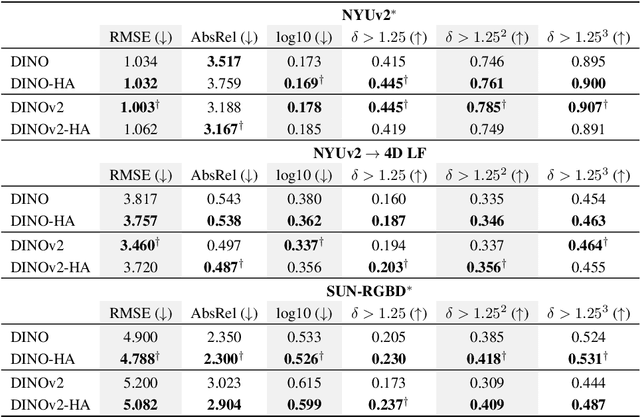
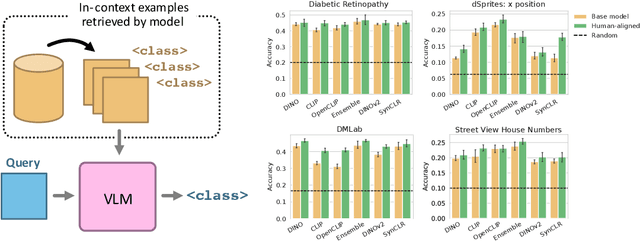
Abstract:Humans judge perceptual similarity according to diverse visual attributes, including scene layout, subject location, and camera pose. Existing vision models understand a wide range of semantic abstractions but improperly weigh these attributes and thus make inferences misaligned with human perception. While vision representations have previously benefited from alignment in contexts like image generation, the utility of perceptually aligned representations in more general-purpose settings remains unclear. Here, we investigate how aligning vision model representations to human perceptual judgments impacts their usability across diverse computer vision tasks. We finetune state-of-the-art models on human similarity judgments for image triplets and evaluate them across standard vision benchmarks. We find that aligning models to perceptual judgments yields representations that improve upon the original backbones across many downstream tasks, including counting, segmentation, depth estimation, instance retrieval, and retrieval-augmented generation. In addition, we find that performance is widely preserved on other tasks, including specialized out-of-distribution domains such as in medical imaging and 3D environment frames. Our results suggest that injecting an inductive bias about human perceptual knowledge into vision models can contribute to better representations.
DreamSim: Learning New Dimensions of Human Visual Similarity using Synthetic Data
Jun 26, 2023Abstract:Current perceptual similarity metrics operate at the level of pixels and patches. These metrics compare images in terms of their low-level colors and textures, but fail to capture mid-level similarities and differences in image layout, object pose, and semantic content. In this paper, we develop a perceptual metric that assesses images holistically. Our first step is to collect a new dataset of human similarity judgments over image pairs that are alike in diverse ways. Critical to this dataset is that judgments are nearly automatic and shared by all observers. To achieve this we use recent text-to-image models to create synthetic pairs that are perturbed along various dimensions. We observe that popular perceptual metrics fall short of explaining our new data, and we introduce a new metric, DreamSim, tuned to better align with human perception. We analyze how our metric is affected by different visual attributes, and find that it focuses heavily on foreground objects and semantic content while also being sensitive to color and layout. Notably, despite being trained on synthetic data, our metric generalizes to real images, giving strong results on retrieval and reconstruction tasks. Furthermore, our metric outperforms both prior learned metrics and recent large vision models on these tasks.
Persistent Nature: A Generative Model of Unbounded 3D Worlds
Mar 23, 2023



Abstract:Despite increasingly realistic image quality, recent 3D image generative models often operate on 3D volumes of fixed extent with limited camera motions. We investigate the task of unconditionally synthesizing unbounded nature scenes, enabling arbitrarily large camera motion while maintaining a persistent 3D world model. Our scene representation consists of an extendable, planar scene layout grid, which can be rendered from arbitrary camera poses via a 3D decoder and volume rendering, and a panoramic skydome. Based on this representation, we learn a generative world model solely from single-view internet photos. Our method enables simulating long flights through 3D landscapes, while maintaining global scene consistency--for instance, returning to the starting point yields the same view of the scene. Our approach enables scene extrapolation beyond the fixed bounds of current 3D generative models, while also supporting a persistent, camera-independent world representation that stands in contrast to auto-regressive 3D prediction models. Our project page: https://chail.github.io/persistent-nature/.
Totems: Physical Objects for Verifying Visual Integrity
Sep 26, 2022



Abstract:We introduce a new approach to image forensics: placing physical refractive objects, which we call totems, into a scene so as to protect any photograph taken of that scene. Totems bend and redirect light rays, thus providing multiple, albeit distorted, views of the scene within a single image. A defender can use these distorted totem pixels to detect if an image has been manipulated. Our approach unscrambles the light rays passing through the totems by estimating their positions in the scene and using their known geometric and material properties. To verify a totem-protected image, we detect inconsistencies between the scene reconstructed from totem viewpoints and the scene's appearance from the camera viewpoint. Such an approach makes the adversarial manipulation task more difficult, as the adversary must modify both the totem and image pixels in a geometrically consistent manner without knowing the physical properties of the totem. Unlike prior learning-based approaches, our method does not require training on datasets of specific manipulations, and instead uses physical properties of the scene and camera to solve the forensics problem.
Any-resolution Training for High-resolution Image Synthesis
Apr 14, 2022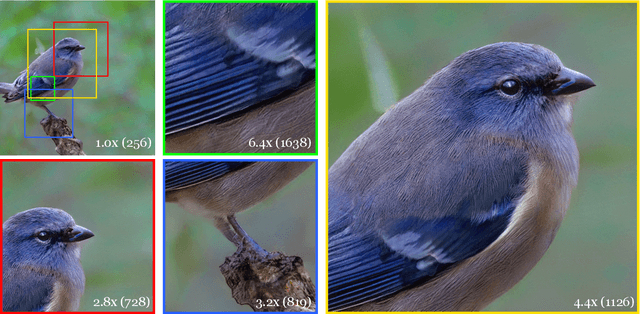
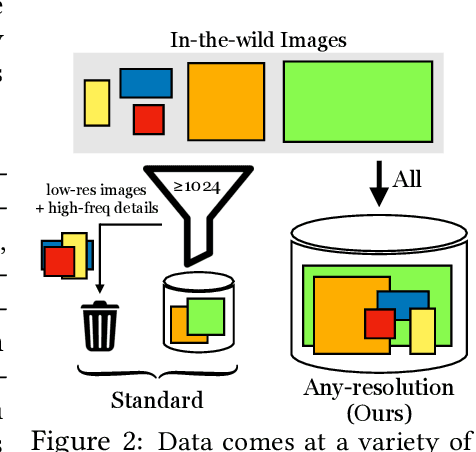
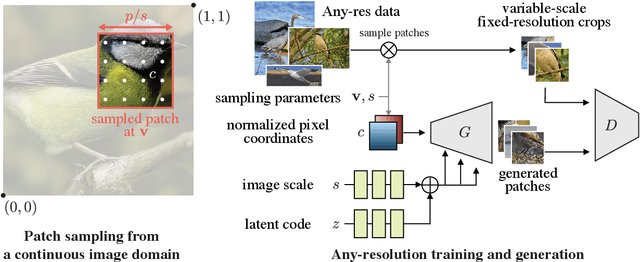
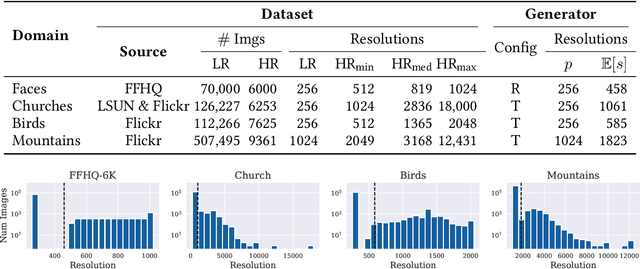
Abstract:Generative models operate at fixed resolution, even though natural images come in a variety of sizes. As high-resolution details are downsampled away, and low-resolution images are discarded altogether, precious supervision is lost. We argue that every pixel matters and create datasets with variable-size images, collected at their native resolutions. Taking advantage of this data is challenging; high-resolution processing is costly, and current architectures can only process fixed-resolution data. We introduce continuous-scale training, a process that samples patches at random scales to train a new generator with variable output resolutions. First, conditioning the generator on a target scale allows us to generate higher resolutions images than previously possible, without adding layers to the model. Second, by conditioning on continuous coordinates, we can sample patches that still obey a consistent global layout, which also allows for scalable training at higher resolutions. Controlled FFHQ experiments show our method takes advantage of the multi-resolution training data better than discrete multi-scale approaches, achieving better FID scores and cleaner high-frequency details. We also train on other natural image domains including churches, mountains, and birds, and demonstrate arbitrary scale synthesis with both coherent global layouts and realistic local details, going beyond 2K resolution in our experiments. Our project page is available at: https://chail.github.io/anyres-gan/.
Ensembling with Deep Generative Views
Apr 29, 2021



Abstract:Recent generative models can synthesize "views" of artificial images that mimic real-world variations, such as changes in color or pose, simply by learning from unlabeled image collections. Here, we investigate whether such views can be applied to real images to benefit downstream analysis tasks such as image classification. Using a pretrained generator, we first find the latent code corresponding to a given real input image. Applying perturbations to the code creates natural variations of the image, which can then be ensembled together at test-time. We use StyleGAN2 as the source of generative augmentations and investigate this setup on classification tasks involving facial attributes, cat faces, and cars. Critically, we find that several design decisions are required towards making this process work; the perturbation procedure, weighting between the augmentations and original image, and training the classifier on synthesized images can all impact the result. Currently, we find that while test-time ensembling with GAN-based augmentations can offer some small improvements, the remaining bottlenecks are the efficiency and accuracy of the GAN reconstructions, coupled with classifier sensitivities to artifacts in GAN-generated images.
Using latent space regression to analyze and leverage compositionality in GANs
Mar 18, 2021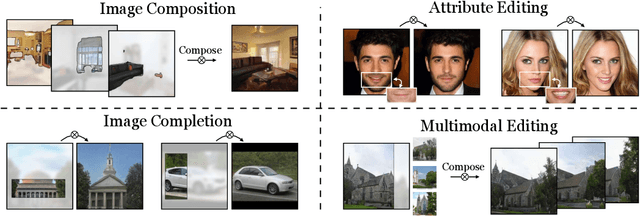



Abstract:In recent years, Generative Adversarial Networks have become ubiquitous in both research and public perception, but how GANs convert an unstructured latent code to a high quality output is still an open question. In this work, we investigate regression into the latent space as a probe to understand the compositional properties of GANs. We find that combining the regressor and a pretrained generator provides a strong image prior, allowing us to create composite images from a collage of random image parts at inference time while maintaining global consistency. To compare compositional properties across different generators, we measure the trade-offs between reconstruction of the unrealistic input and image quality of the regenerated samples. We find that the regression approach enables more localized editing of individual image parts compared to direct editing in the latent space, and we conduct experiments to quantify this independence effect. Our method is agnostic to the semantics of edits, and does not require labels or predefined concepts during training. Beyond image composition, our method extends to a number of related applications, such as image inpainting or example-based image editing, which we demonstrate on several GANs and datasets, and because it uses only a single forward pass, it can operate in real-time. Code is available on our project page: https://chail.github.io/latent-composition/.
What makes fake images detectable? Understanding properties that generalize
Aug 24, 2020



Abstract:The quality of image generation and manipulation is reaching impressive levels, making it increasingly difficult for a human to distinguish between what is real and what is fake. However, deep networks can still pick up on the subtle artifacts in these doctored images. We seek to understand what properties of fake images make them detectable and identify what generalizes across different model architectures, datasets, and variations in training. We use a patch-based classifier with limited receptive fields to visualize which regions of fake images are more easily detectable. We further show a technique to exaggerate these detectable properties and demonstrate that, even when the image generator is adversarially finetuned against a fake image classifier, it is still imperfect and leaves detectable artifacts in certain image patches. Code is available at https://chail.github.io/patch-forensics/.
 Add to Chrome
Add to Chrome Add to Firefox
Add to Firefox Add to Edge
Add to Edge